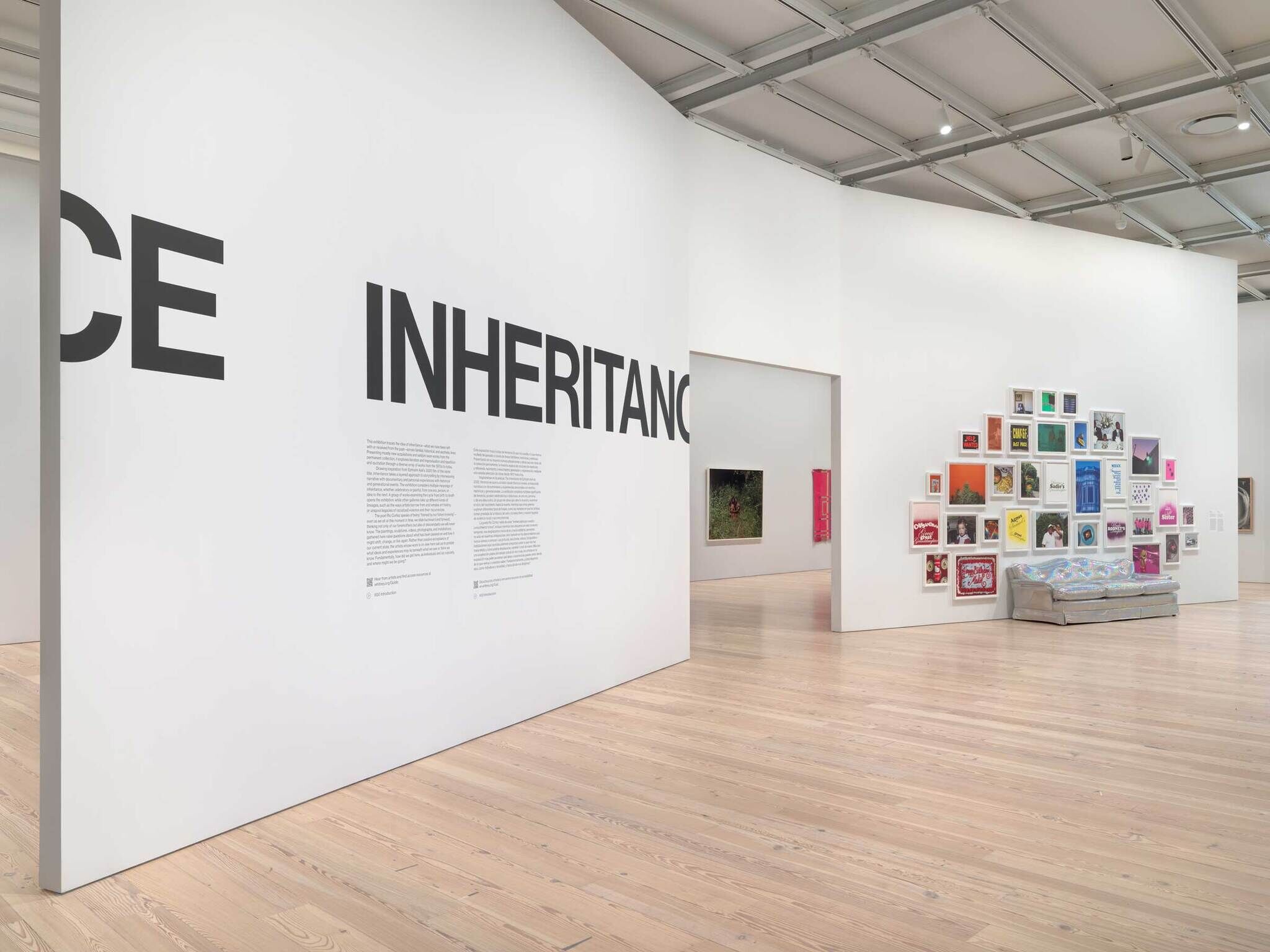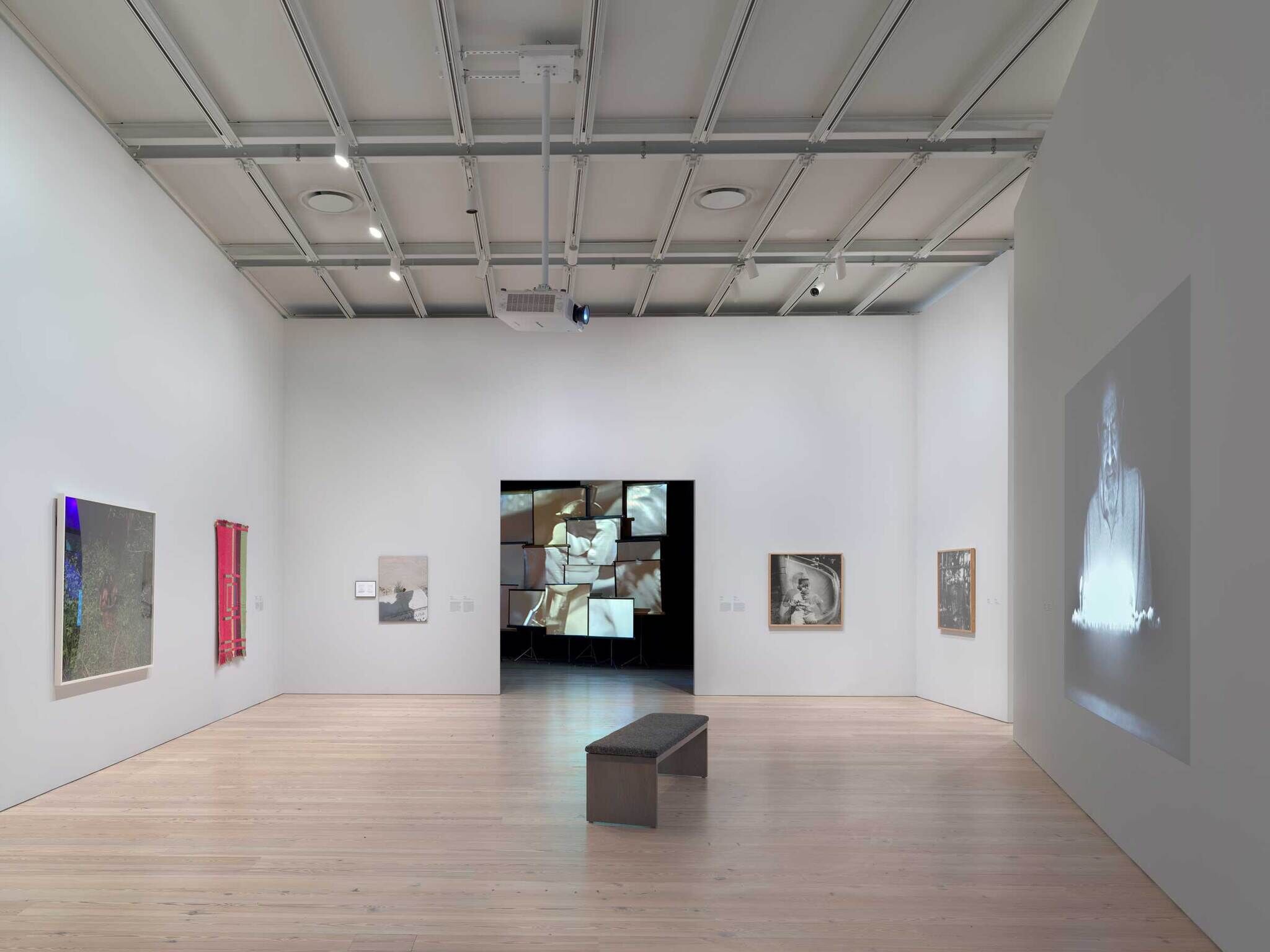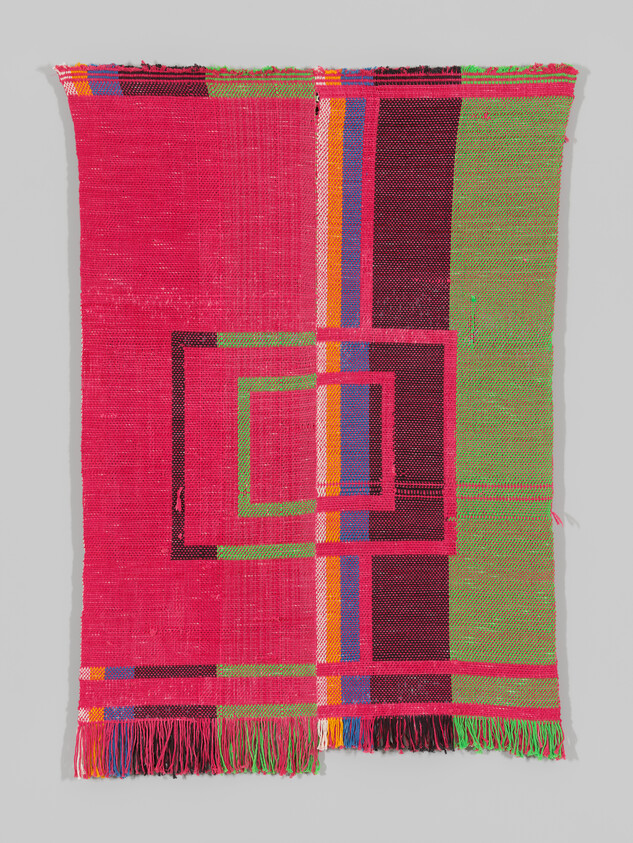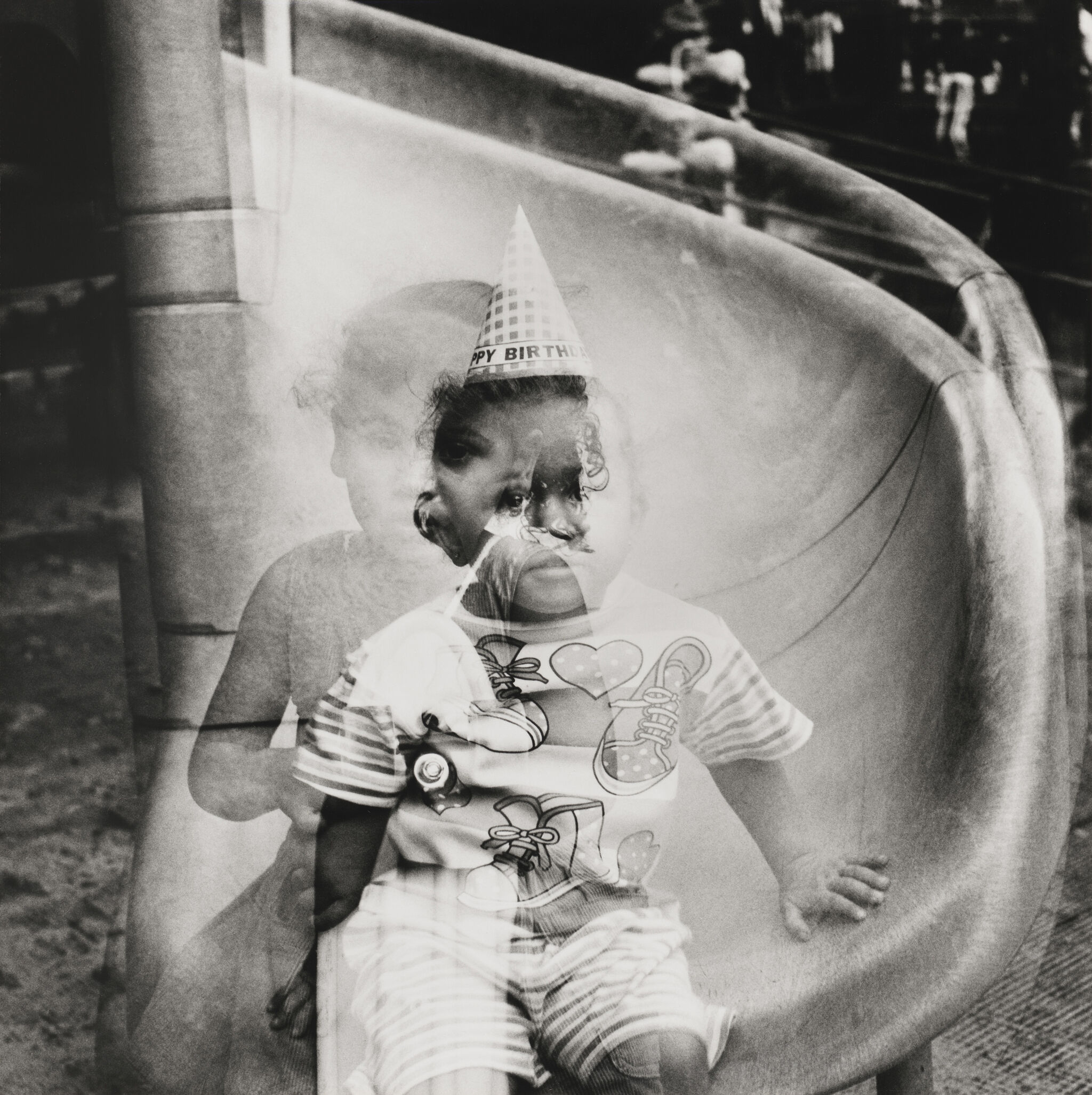Visual description
Measuring 64 × 48 × ½ inch, Diedrick Brackens’s they spring from the embers of my mouth is a vertical, geometric double woven textile made of cotton yarn. Beginning at the top, two thin magenta bands span horizontally from edge to edge. Underneath those bands are sections of varying widths in light pink, orange, purple, dark reddish brown, and lime green. The majority of the left side of the textile is magenta until the bottom portion where the magenta is interrupted by the bands of colors seen at the top. To the right of the magenta section are relatively narrow strips of light pink, orange, and purple that run vertically from the top edge to the bottom edge. Two larger sections, one dark reddish brown, and one lime green, also run from top to bottom. In the center of the textile are two thin, outlined rectangles. The larger outer rectangle is dark reddish brown on the left, lime green towards the middle, and magenta on the right. The smaller inner rectangle is evenly divided into lime green on the left and magenta on the right. The rectangles and stripes at the top and bottom of the textile demonstrate Brackens' double-weave textile process, in which two cloths are woven in tandem and the separate warp and weft colors alternate throughout a textile. In the rectangle, the warp and the weft vary completely from the rest of the textile. This, paired with Brackens' vibrant color choice, creates a high contrast abstraction. Towards the bottom of the textile, the bands from the top are repeated in two parallel lines before ending at an uneven frayed edge. Loose threads dangle, suggesting an incompleteness. It should be noted that not all of the panels of the textile appear to be on the same plane. The colors alternate between weft and warp, giving the impression of subtle depth.
they spring from the embers of my mouth is both a commentary and articulation on the artist’s relationship with genetic ancestry. From the results of a personalized DNA report, Brackens created a set of algorithms reflecting different genetic traits. He then translated and rendered those traits into woven multicolored threads. Through this act of translation and rendering, this abstract textile doubles as something akin to a self-portrait.
Not on view
Date
2019
Classification
Textiles
Medium
Cotton yarn
Dimensions
Overall: 64 × 48 × 1/2 in. (162.6 × 121.9 × 1.3 cm)
Accession number
2020.178
Credit line
Gift of Nancy and David Frej
Rights and reproductions
© Diedrick Brackens
Videos
Audio
-
Descripción verbal: Diedrick Brackens, they spring from the embers of my mouth, 2019
In Inheritance (Spanish)
0:00
Descripción verbal: Diedrick Brackens, they spring from the embers of my mouth, 2019
0:00
Narrator: La obra de Diedrick Brackens they spring from the embers of my mouth es un tejido vertical doble de hilo de algodón y formas geométricas de 162 centímetros de alto, 122 centímetros de ancho y poco más de un centímetro de espesor. Desde arriba, dos bandas finas de color magenta se extienden en sentido horizontal de borde a borde. Por debajo de esas bandas, puede ver secciones de tejido de distintos anchos de color rosa claro, naranja, púrpura, marrón rojizo oscuro y verde lima. La mayor parte de la mitad izquierda del tejido es de color magenta, pero en la parte inferior los colores que se ven arriba cruzan por encima del magenta. A la derecha de la sección de color magenta se pueden observar líneas relativamente finas de color rosa claro, naranja y púrpura que se extienden en sentido vertical desde el borde superior hasta el borde inferior del tejido. Dos secciones más grandes, una de color marrón rojizo oscuro y la otra de color verde lima, también se extienden desde arriba hacia abajo. En el centro del telar, se delinean dos rectángulos con bordes finos. El rectángulo externo es de color marrón rojizo oscuro en el extremo izquierdo, verde lima en el medio, y magenta en la mitad derecha. El rectángulo interno está dividido exactamente a la mitad en color verde lima a la izquierda y magenta a la derecha. Los rectángulos y las líneas en la parte superior e inferior del tejido dejan en evidencia el proceso de tejido de punto doble que realiza Brackens, que consiste en tejer dos piezas de tela en conjunto y las urdimbres y las tramas individuales de colores se van alternando a lo largo y ancho del tejido. En el rectángulo, la urdimbre y la trama son completamente distintas de las del resto del tejido. En conjunto con los colores vibrantes que eligió Brackens, esto crea una abstracción de contraste alto. Hacia la parte inferior del tejido, las bandas de arriba se replican en dos líneas paralelas antes de concluir con un acabado deshilachado y desigual. Los hilos sueltos que cuelgan sugieren un sentido de incompletitud. Cabe mencionar que no todos los paneles del tejido parecen estar en el mismo plano. Los colores alternan entre la urdimbre y la trama, y esto da la impresión de una profundidad sutil.
they spring from the embers of my mouth es, al mismo tiempo, una observación social y personal de la relación que el artista entabla con su ascendencia genética. A partir de los resultados de una prueba personalizada de ADN, Brackens creó una serie de algoritmos que reflejan distintos rasgos genéticos. Luego, tradujo y plasmó dichos rasgos en hilos tejidos de muchos colores. A partir de este proceso de traducción y plasmado, este tejido abstracto funciona a la vez como una obra afín a un autorretrato.
-
0:00
Verbal Description: Diedrick Brackens, they spring from the embers of my mouth, 2019
0:00
Narrator: Measuring 64 × 48 × ½ inch, Diedrick Brackens’s they spring from the embers of my mouth is a vertical, geometric double woven textile made of cotton yarn. Beginning at the top, two thin magenta bands span horizontally from edge to edge. Underneath those bands are sections of varying widths in light pink, orange, purple, dark reddish brown, and lime green. The majority of the left side of the textile is magenta until the bottom portion where the magenta is interrupted by the bands of colors seen at the top. To the right of the magenta section are relatively narrow strips of light pink, orange, and purple that run vertically from the top edge to the bottom edge. Two larger sections, one dark reddish brown, and one lime green, also run from top to bottom. In the center of the textile are two thin, outlined rectangles. The larger outer rectangle is dark reddish brown on the left, lime green towards the middle, and magenta on the right. The smaller inner rectangle is evenly divided into lime green on the left and magenta on the right. The rectangles and stripes at the top and bottom of the textile demonstrate Brackens' double-weave textile process, in which two cloths are woven in tandem and the separate warp and weft colors alternate throughout a textile. In the rectangle, the warp and the weft vary completely from the rest of the textile. This, paired with Brackens' vibrant color choice, creates a high contrast abstraction. Towards the bottom of the textile, the bands from the top are repeated in two parallel lines before ending at an uneven frayed edge. Loose threads dangle, suggesting an incompleteness. It should be noted that not all of the panels of the textile appear to be on the same plane. The colors alternate between weft and warp, giving the impression of subtle depth.
they spring from the embers of my mouth is both a commentary and articulation on the artist’s relationship with genetic ancestry. From the results of a personalized DNA report, Brackens created a set of algorithms reflecting different genetic traits. He then translated and rendered those traits into woven multicolored threads. Through this act of translation and rendering, this abstract textile doubles as something akin to a self-portrait.
-
0:00
Diedrick Brackens, they spring from the embers of my mouth, 2019
0:00
Rujeko Hockley: Aquí observamos una obra tejida con hilo de algodón. Diedrick Brackens es un artista textil que crea sus propios tejidos en telar en su estudio. Crea algoritmos propios en los tejidos, siguiendo los resultados que obtiene en términos de color y en términos de la forma que busca lograr.
Es una obra abstracta que al mismo tiempo es un autorretrato. Está hecha a partir de pruebas de ADN personalizadas de los ancestros genéticos de Brackens, que luego el artista utilizó para diseñar un patrón y crear el tejido. La obra nos dice, a la vez, todo sobre él, su genética, su ADN, sus antepasados, las partes de su ascendencia que provienen de cierta parte del mundo, de cierta etnia, con cierto porcentaje, y lo convierte en algo que ya no se puede interpretar desde ese enfoque, pero que no deja de tratarse de él de forma muy directa.
Creo que es una decisión deliberada la de reiterar la cualidad abstracta del ADN, la información que recibimos de estos informes en los que pedimos datos sobre nuestros antepasados, y también la idea de ascendencia, de herencia, de lo que llega a nuestras vidas desde el pasado, cuánto podemos llegar a saber o no saber incluso sobre nuestros padres. Y por supuesto sobre nuestros abuelos, bisabuelos, esos antepasados que jamás conocimos y de los que jamás sabremos ni siquiera sus nombres.
-
0:00
Diedrick Brackens, they spring from the embers of my mouth, 2019
0:00
Rujeko Hockley: We are looking at a woven work, made of cotton yarn. Diedrick Brackens is a textile artist who creates his own weavings on a loom in his studio. He creates his own algorithms for the weavings, based on the outcomes in terms of color, in terms of form that he is interested in achieving.
The piece is an abstraction that is also a self-portrait. It is based on personalized DNA reports of Brackens's genetic ancestry, which he turned into a pattern to make the textile from. So, it's simultaneously telling us everything about him, his genetic makeup, turning his DNA, his ancestry, the portions of his ancestry that are from X part of the world, X ethnicity, X percentage, and turning it into something that is no longer legible through that lens, but still is obviously about him very directly.
I think that is an intentional choice to both reiterate the abstraction that is both DNA, the information that we receive from these send away for your ancestry kits, and then also even just the idea of ancestry, of inheritance, of what comes to us from the past, how much we can ever know or not know about even our parents. But also of course our grandparents, our great-grandparents, our ancestors that we have never met and will never know even their names.
Exhibitions
Installation photography
-


Installation view of Inheritance (Whitney Museum of American Art, New York, June 28, 2023—February, 2024.). From left to right: Deana Lawson, The Garden, Gemena, DR Congo, 2015; Diedrick Brackens, they spring from the embers of my mouth, 2019; Sadie Barnette, Family Tree II, 2022. Photograph by Ron Amstutz
From the exhibition Inheritance
-


Installation view of Inheritance (Whitney Museum of American Art, New York, June 28, 2023—February, 2024.). From left to right: Deana Lawson, The Garden, Gemena, DR Congo, 2015; Diedrick Brackens, they spring from the embers of my mouth, 2019; Emily Jacir, Munir, 2001-03; Bruce and Norman Yonemoto, Environmental, 1993; Sophie Rivera, I am U, 1995; Sophie Rivera, Terracotta Goddess, n.d.; Kevin Jerome Everson, Ninety-Three, 2008. Photograph by Ron Amstutz
From the exhibition Inheritance


